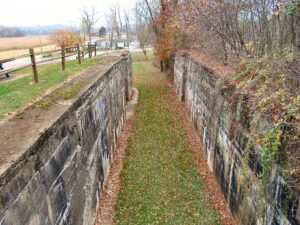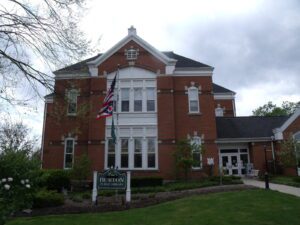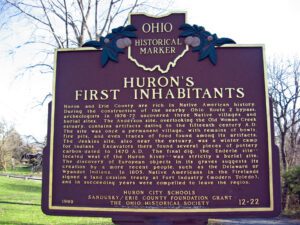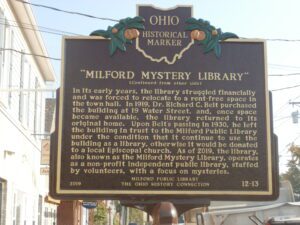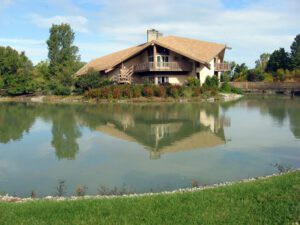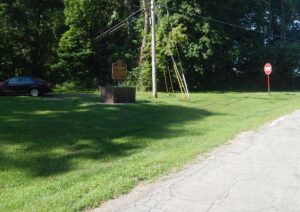, OH
The Upper Trenton Lock (Lock 15 South) of the Ohio & Erie Canal was built between 1828 and 1829. Originally built of cut sandstone blocks, the lock was named for the Village of Trenton, now Tuscarawas. Lock 16, or Lower Trenton Lock, lies only 800 feet southwest of Lock 15. The lock tender, who lived in a house on this site, served both locks. Repeated flood damage prompted reconstruction of Lock 15 in 1907. The deteriorated stonemasonry was completely replaced with concrete at a cost of $6,815. The old stone was used to shore up the towpath. Use of the state-owned canal had declined significantly by this point, and the great flood of 1913 brought the canal era to an end in Ohio.
, OH
This Queen Anne style building with segmental-arched windows and steep hipped roof was Burton’s second high school. Completed in 1885 at a cost of $12,500, it is wood framed with a brick and stone exterior, modeled after an academy in River Falls, Wisconsin. Its basement and two upper floors contained 12,720 square feet of space, enough for all twelve grades. There were two separate entrances; girls entered on the left and boys on the right. Electricity was installed in 1921 by the superintendent and students. Classes met here until 1936. During its history, the building housed various organizations, including the Red Cross, Opportunity School of Geauga County (later Metzenbaum), Geauga County Historical Society, American Legion, and County Extension Office. In 1937, it became the home of the Burton Public Library and in 1983 was expanded with a north wing designed to be architecturally consistent with the original 1885 structure.
, OH
Huron and Erie County are rich in Native American history. During the construction of the nearby Ohio Route 2 bypass, archeologists in 1976-77 uncovered three Native villages and burial sites. The Anderson site, overlooking the Old Woman Creek estuary, contains artifacts dating to the fifteenth century A.D. The site was once a permanent village, with remains of bowls, fire pits, and even traces of food found among its artifacts. The Jenkins site, also near the estuary, was a winter camp for Indians. Excavators there found several pieces of pottery carbon-dated to 1470 A.D. The final dig, the Enderle site — located west of the Huron River — was strictly a burial site. The discovery of European objects in its graves suggests its creation by a more recent people, such as the Delaware or Wyandot Indians. In 1805, Native Americans in the Firelands signed a land cession treaty at Fort Industry (modern Toledo), and in succeeding years were compelled to leave the region.
, OH
The Milford Public Library, Clermont County’s oldest continuously operating library, was founded in 1900 by a local civic organization, the Milford Village Improvement Society. It was preceded by a circulating library–one that charges patrons for renting books–that was chartered in 1822. At the time of the Milford Public Library’s founding, circulating libraries were in decline and public libraries were increasing in number as an inexpensive alternative. To obtain support for their proposed “reading room,” the Society’s Literary Committee travelled door-to-door, soliciting members and books. To become a member of the library, adults paid 25 cents and children paid 10 cents in annual dues. The library’s first–and current–home is the stone building at 19 Water Street. (Continued on other side)
, OH
A dense swamp forest roughly the size of the state of Connecticut once stretched across this region of Ohio and Indiana. A remnant of ancient Lake Maumee, this dense, soggy flatland supported abundant waterfowl and wildlife, but blocked travel and settlement and remained largely uninhabited until it was cleared and drained for agriculture between 1860 and 1885. This marsh and other scatter remnants are all that remain of the Great Black Swamp. Managed for a variety of wetland wildlife, Magee is one of the premier bird watching sites in North America, with more than 300 species.
, OH
Alexander Sutherland (1767-1845) and his wife Sarah (1768-1836) were the first settlers in Newton Township, Trumbull County, Ohio. Coming from Westmoreland County, Pennsylvania, the Sutherlands acquired 205 acres of land along Duck Creek southward from this site. Alexander was an influential person in the area after the settlement was made at Duck Creek. He was the second Recorder and the first elected Surveyor for Trumbull County. He was an early Mason with Old Erie Lodge, Warren schoolteacher, postmaster at Newton, Newton Township Trustee and Clerk, and Justice of the Peace. Sutherland, along with Ezekiel Hover, marked the first path from this Duck Creek settlement to Youngstown to reach the nearest mill.
, OH
Company E of the 30th Ohio Volunteer Infantry was the only full infantry company formed in Jerome Township. Capt. Elijah Warner organized the unit in the village of Jerome and it was mustered into the Union Army at Camp Chase in Columbus on August 29, 1861. A total of 102 men from the township fought in the regiment throughout the war, while approximately 25% of the total population of the Jerome Township served. Company E performed outstanding service, participating in the Antietam, Vicksburg, and Atlanta Campaigns, Sherman’s March to the Sea and the March through the Carolinas, and the in the Grand Review in Washington, D.C. Of the 102 Jerome Township men in Company E, 32 perished during the war. The regiment was mustered out of service August 13, 1865.
, OH
A group of concerned Cincinnati women organized, in 1855, The Protestant Home for the Friendless and Female Guardian Society as a private, not-for-profit maternity home for destitute women and children. These public minded social leaders were aware that Cincinnati had grown beyond the time when the poor or unfortunate were cared for by their neighbors. The Home, which was funded through bequests and personal donations, was founded to care for poor mothers and babies, unmarried pregnant women, wanderers and strangers in the city, and to promote adoptions. (Continued on other side)


